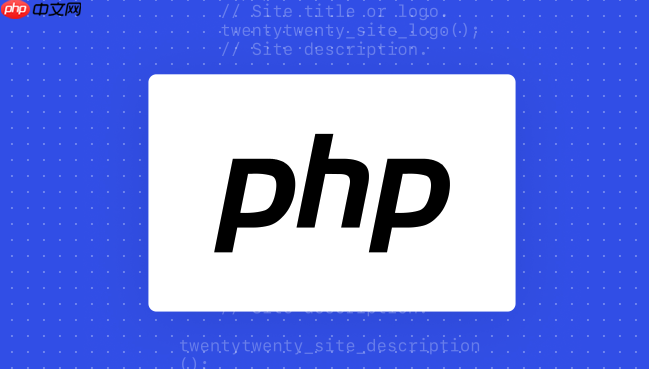要在php中处理grpc请求,首先安装并启用grpc扩展;1. 安装grpc扩展并通过pecl启用;2. 编写.proto文件定义服务接口和消息格式;3. 使用protoc生成php代码;4. 实现生成的接口以创建grpc服务类;5. 创建并运行grpc服务器脚本。错误处理可通过返回状态码、抛出异常或使用拦截器实现;性能优化包括使用流式传输、启用压缩、连接池复用、调整并发参数及优化protobuf定义;身份验证可采用token-based认证、mutual tls或通过拦截器集中处理验证逻辑。

处理gRPC请求在PHP中需要一些特定的设置和库,但总的来说,它可以让你构建高性能的微服务,并与其他使用gRPC的服务进行通信。简单来说,你需要安装gRPC扩展,定义你的protobuf协议,然后编写PHP代码来处理这些请求。

解决方案

安装gRPC扩展:
立即学习“PHP免费学习笔记(深入)”;
这是首要步骤。你需要通过PECL安装gRPC扩展。在你的终端中运行:

pecl install grpc
安装完成后,确保在你的php.ini文件中启用该扩展。添加或取消注释以下行:
extension=grpc.so
然后重启你的Web服务器或PHP-FPM。
定义Protobuf协议:
gRPC使用Protocol Buffers (protobuf) 来定义服务接口。你需要编写.proto文件来描述你的服务和消息格式。例如,创建一个名为example.proto的文件:
syntax = "proto3";
package example;
service Greeter {
rpc SayHello (HelloRequest) returns (HelloReply) {}
}
message HelloRequest {
string name = 1;
}
message HelloReply {
string message = 1;
}生成PHP代码:
使用protobuf编译器protoc,根据.proto文件生成PHP代码。你需要安装protoc编译器,并确保它在你的PATH中。然后运行以下命令:
protoc --php_out=. --grpc_out=. --plugin=protoc-gen-grpc=/path/to/grpc_php_plugin example.proto
--php_out=. 指定PHP代码的输出目录。--grpc_out=. 指定gRPC代码的输出目录。--plugin=protoc-gen-grpc=/path/to/grpc_php_plugin 指定gRPC PHP插件的路径。这个插件通常位于你的gRPC扩展的安装目录中。这会生成两个PHP文件:Example\GreeterInterface.php 和 Example\HelloRequest.php等。
实现gRPC服务:
创建一个类来实现生成的GreeterInterface接口。例如,创建一个名为GreeterService.php的文件:
<?php
namespace Example;
class GreeterService implements GreeterInterface {
public function SayHello(HelloRequest $request): HelloReply {
$name = $request->getName();
$message = "Hello, " . $name . "!";
$reply = new HelloReply();
$reply->setMessage($message);
return $reply;
}
}创建gRPC服务器:
创建一个PHP脚本来启动gRPC服务器。例如,创建一个名为server.php的文件:
<?php
require __DIR__ . '/vendor/autoload.php'; // 假设你使用了Composer
use Example\GreeterService;
$server = new \Grpc\Server();
$server->addService('example.Greeter', new GreeterService());
$server->usePort("0.0.0.0:50051", [
'credentials' => \Grpc\ChannelCredentials::createInsecure(),
]);
$server->start();这里,我们创建了一个gRPC服务器,添加了GreeterService,并监听50051端口。
运行gRPC服务器:
在终端中运行服务器脚本:
php server.php
服务器现在应该开始监听gRPC请求。
处理错误和异常是构建健壮gRPC应用的关键。在PHP中,你可以通过以下几种方式来处理:
\Grpc\STATUS常量来设置状态码,并在响应中包含错误信息。例如:
<?php
namespace Example;
use Grpc\STATUS;
class GreeterService implements GreeterInterface {
public function SayHello(HelloRequest $request): HelloReply {
$name = $request->getName();
if (empty($name)) {
throw new \Exception("Name cannot be empty", STATUS::INVALID_ARGUMENT);
}
$message = "Hello, " . $name . "!";
$reply = new HelloReply();
$reply->setMessage($message);
return $reply;
}
}gRPC旨在提供高性能的通信,但仍有一些优化技巧可以进一步提升性能:
packed修饰符可以优化数组的编码。身份验证是保护gRPC服务的重要手段。在PHP中,你可以使用多种方式来实现身份验证:
例如,使用Token-based authentication:
客户端:
<?php
use Example\GreeterClient;
use Grpc\ChannelCredentials;
$client = new GreeterClient('localhost:50051', [
'credentials' => ChannelCredentials::createInsecure(),
'headers' => [
'authorization' => 'Bearer YOUR_TOKEN',
],
]);服务端 (使用拦截器):
<?php
use Grpc\Interceptor;
use Grpc\ServerInterceptor;
use Grpc\UnaryCall;
class AuthInterceptor implements ServerInterceptor {
public function __construct(private string $token) {}
public function interceptUnary(UnaryCall $call, $method, $handler) {
$metadata = $call->getMetadata();
if (!isset($metadata['authorization']) || $metadata['authorization'][0] !== 'Bearer ' . $this->token) {
return new \Grpc\Status(\Grpc\STATUS_PERMISSION_DENIED, 'Invalid token');
}
return $handler($call);
}
}
$server = new \Grpc\Server();
$server->addService('example.Greeter', new GreeterService());
$server->addUnaryServerInterceptor(new AuthInterceptor('YOUR_SECRET_TOKEN'));
$server->usePort("0.0.0.0:50051", [
'credentials' => \Grpc\ChannelCredentials::createInsecure(),
]);
$server->start();以上就是PHP怎样处理gRPC请求 PHP处理gRPC请求完整教程的详细内容,更多请关注php中文网其它相关文章!

PHP怎么学习?PHP怎么入门?PHP在哪学?PHP怎么学才快?不用担心,这里为大家提供了PHP速学教程(入门到精通),有需要的小伙伴保存下载就能学习啦!

Copyright 2014-2025 https://www.php.cn/ All Rights Reserved | php.cn | 湘ICP备2023035733号